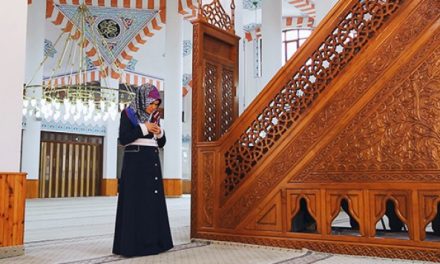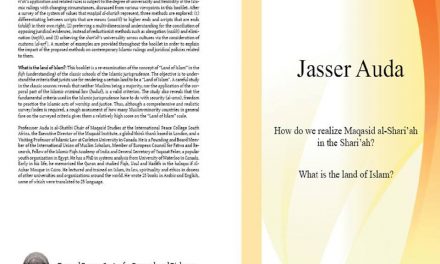
How men and women should line up in a mosque? This is the question discussed by Dr. Jasser Auda in this part of the series. In part 1, Dr. Auda argued that isolating women from men in mosques does not follow the practice of the Prophet nor does it conform to the design of his Mosque during his lifetime. Part 2 highlighted the advantages women acquire when they share the same mosque hall with men and, thus, be able to learn directly form the Imam.
The Hadith on the worst of rows and its meaning
There is a Hadith reported by Abu Hurayrah, in which the Prophet (peace and blessings be upon him) stated that:
“The best of men’s rows are the frontward ones and their worst are their rearward ones, while women’s best rows are its rearward ones and their worst are their frontward ones.”[1]
Some people draw on this Hadith to prevent women from attending prayer at mosques at all, or for isolating them in separate halls. This is a strange interpretation, since the Prophet (peace and blessings be upon him) could have got another prayer hall built for women alone or even prevented them from performing prayers in mosques from the very beginning. Yet, he absolutely did neither.
The Hadith rather asserts the preference of men’s standing in the first rows and women’s standing in the last rows in prayer, nothing else. This is meant for reasonable considerations and justifications, first of which is that the front men’s row and the rear women’s row are the ones filled by those who come earlier to mosque, which is a well-known virtue.
Second, these two rows are better in helping the praying persons avoid distractions that may take place in the rest of the mosque, and this entails uninterrupted concentration and devotion in prayer.
Third, this instruction is in harmony with other Hadiths in which the Prophet (peace and blessings be upon him) forbade praying women from raising their heads (from prostration) before men, to give men enough time to maintain cover their bodies properly; at the time, due to the poor economic situation in the nascent Muslim community, not all Companions could afford long clothes that would cover them properly during prostration.
it was narrated from Asma’ that she said: I heard the Prophet (peace and blessings be upon him) say, “Whoever of you believes in Allah and in the Last Day should not raise her head until we (the men) raise our heads (after prostration),” lest they should see the private parts of men because their lower garments were short…[2]
Similarly, Sahl ibn Sad said, during the Prophet’s time, women were ordered not to raise their heads [from sujood] until men are fully seated due to the inappropriate (in another narration, the small) clothes [worn by men]
Another narration added, “So, guard your sights from seeing men’s private parts”[3]
Narrated `Amr ibn Salamah:
….So they looked for such a person and found none who knew more Quran than I because of the Quranic material which I used to learn from the caravans. They therefore made me their Imam (to lead the prayer) and at that time I was a boy of six or seven years, wearing a Burdah (i.e. a black square garment) that was so short that when I prostrate, it shrinks [exposing] my body. A lady from the tribe said, “Won’t you cover the anus of your reciter for us?” So they bought (a piece of cloth) and made a shirt for me. I had never been so happy with anything before as I was with that shirt.[4]
So, this is one of the reasons for separating the rows and encouraging women to be in the rear row.
Hence, the general ruling regarding the rows is that the first (frontward) row is recommended for men followed by the second , then the third rows. The same applies to women’s rows who offer their congregation prayer in the absence of men’s congregation.
However, if women offer prayer in the same place where men’s congregational prayer is offered, then the best of their rows are the last (rearward) ones, and so on.[5]
Man’s prayer gets interrupted by a passing woman?
Some people object to such open design of mosques drawing on the opinion that man’s prayer is interrupted when a woman passed in front of him; some even believe that he has to repeat his prayer.
To support this opinion, the following narration is quoted:
Abu Hurayrah and Abu Dhar reported that the Prophet (peace and blessings be upon him) said, “Prayer is interrupted by a woman, a dog and a donkey [when they pass in front of a praying person]”.[6]
In fact, this contradicts the mutawatir reports about the Prophet’s Mosque. Besides, these narrations conflict with other reports that indicate the exact opposite, some of which are even reported by the same narrators of this Hadith. It was reported from Abu Huraryrah himself that the Prophet (peace and blessings be upon him) said,
“A person’s prayer is not interrupted by a woman, a dog, or a donkey, and drive back whatever passes in front of you [and within your hand’s reach] as much as you can.”[7]
However, the authenticity of this narration is not established.
Furthermore, if the Hadiths maintaining that “a person’s prayer is interrupted” are more authentic in terms of its chains of narration than the Hadiths maintaining that “a person’s prayer is not interrupted”, then the decisive statement on that issue is the authentic Hadith reported by Muslim and others from lady `A’ishah (Mother of the Believers, may Allah be pleased with her) criticizing the former narrations as inaccurate:
`Abdullah ibn `Ubaydullah ibn `Umayr reported that when `A’ishah was asked about the narrations to the effect that (the passing of) a dog, a woman, and a donkey interrupt one’s prayer, she stated, “Would you hold these (animals) equal to a Muslim woman?”
(In another narration, she said, “How bad that you hold us equal to the donkey and the dog”, and in a third narration, “A woman would then be (viewed as) an ugly animal!”).
I have witnessed occasions on which I would wake up while the Prophet (peace and blessings be upon him) was offering prayer with me lying interposed between him and the Qiblah.”[8]
In another narration, she said, “with me lying interposed between him and the Qiblah like the bier of a corpse in a funeral prayer.”[9]
Ash-Shafi`i commented on this issue saying, “If a woman’s presence in front of a praying person does not invalidate his prayer, then it is more entitling that her presence to his right or to his left does not (invalidate it too)”.[10]
Besides, Muhammad ibn Al-Hassan said,
“There is no harm if a man prays while his wife is lying, standing or sitting in front of him or to his side, or while she is praying as long as she is offering a different prayer than that he is offering. For it is disliked that she offers the same prayer he is offering, while being by his side or in front of him, or if both are offering prayer behind the same Imam.”[11]
According to the Hanbalis,
“A man’s prayer while a woman is praying in front of him is disliked; otherwise – if she is not praying – then it is not disliked (for him to pray then),” drawing on the above quoted Hadith of lady `A’ishah.[12]
Abu Dawud noted the conflicting reports on this issue despite the practice of the Companions (may Allah be pleased with them), which maintains the effect that nothing interrupted prayer, and said, “If two reports from the Prophet (peace and blessings be upon him) conflict, we should refer to the established practice of his Companions after him.”[13]
* Translated from the Arabic original by AboutIslam.net. Sources referenced in the endnotes are the Arabic works, not their English translations.
[1] Muslim, Chapter on Prayer, 2/32.
[2] Ahmad’s Musnad, 44/511. Al-Arna’ut said: This Hadith is Sahih (authentic) by virtue of another Hadith that supports it, and this chain of narration is weak, due to the doubt about Asma’s freed female-slave [who is listed as a narrator of the hadith], knowing that some other narrations read, “male-slave of Asma’”. Besides, Al-Hafizh Al-Mazziy mentioned his biograhphy in his Tahdhib Al-Kamal among the anonymous male narrators, saying, “If he is not `Abdullah ibn Kaysan, then I do not know who he is”, though the rest of narrators in the chain are trustworthy, being judged as such by Al-Bukhari and Muslim.
[3] Ibn Khuzaimah’s Sahih 2/817; Mawarid Az-Zam’an 1/136
[4] Al-Bukhari 5/150.
[5] See for example Al-Majmu` Sharh Al-Muhadhdhab, 4/301, Bada’i` As-Sana’i` Fi Tartib Ash-Shar’i`, 1/195, and other sources that maintain the same ruling on this issue.
[6] See Muslim’s Sahih, 1/365 and Ahmad’s Musnad, 2/299. Shu`ayb Al-Arna’ut commented on this Hadith saying that its narrators are trustworthy narrators approved by Al-Bukhari and Muslim, though a considerable controversy occurred regarding Qatadah. It is also reported in Ibn Hibban’s Sahih, 6/151, Ibn Majah’s Sunan, 1/305, and in other sources.
[7] Reported in Ad-Daraqutni’s Sunan, 2/196, and other narrations to the same effect are reported in Abu Dawud’s Sunan, Malik’s Muwatta’ and Ahmad’s Musnad.
[8] See Is-haq ibn Rahawayh’s Musnad, 3/613, Ibn Hibban’s Sahih, 6/111, and Abu Dawud’s Sunan, 1/198. Al-Albani, commenting on Abu Dawud’s narration, said that it is “authentic”.
[9] See Muslim’s Sahih, 1/366.
[10] Al-Um, 1/198.
[11] Al-Muwatta’, Muhammad ibn Al-Hassan’s narration, 2/58.
[12] Kashshaf Al-Qina` `An Matn Al-Iqna`, 1/330.
[13] Abu Dawud’s Sunan, 2/44.





